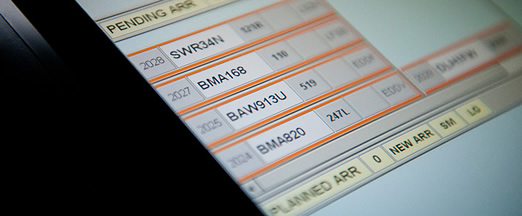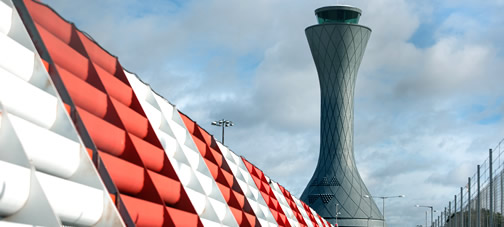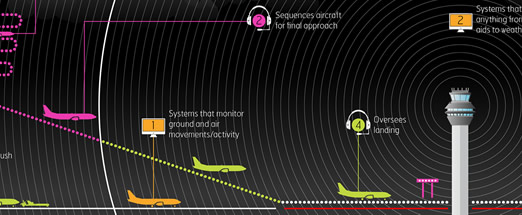The anatomy of a flight strip
6 May 2015A while back NATS tweeted an image of the electronic flight strip and a follower asked if we’d explain the information the strip contains.
In simple terms, an electronic flight strip is a way for an air traffic controller to see all the relevant information about a specific aircraft; what it’s doing and where it’s going. There are actually different types of strip and as a tower controller I’m going to walk you through what I use: Electronic Flight Progress System (EFPS).
This is an outbound strip. You can tell that very easily because it has a blue outline, whereas arrivals are always orange.
If we move from left to right I’ll take each bit of information in turn. First is the slot time, by which we mean the calculated take-off time. This shows the ideal time for us to get a flight airborne to fit in with airspace regulations en-route. Of course this may change depending on a whole range of factors, from the weather through to any airspace capacity restrictions, so it gets updated automatically.
Next is the callsign, something that is probably recognisable to most of you. Every airline has a three letter identification. In this case SWR is for Swiss Air and the three digits identify the specific flight.
In the next section we have information on the aircraft’s wake category – important for getting the right separation distances – and type. This is an Airbus A320, which is a ‘medium’ aircraft, while 7030 is its transponder code.
The ‘I’ indicates that the flight is operating under Instrument Flight Rules (IFR). Although we do get some Visual Flight Rules traffic at Heathrow, such as police helicopters flying through the control zone, the vast majority of our traffic operates as IFR.
LOK refers to one of the holding points around the airport. One of the departure controller’s primary tasks is to make sure you depart aircraft in the best and most efficient order possible, taking into account their departure route and wake category. Ideally you group similar sized aircraft together and try to ensure departures are heading in diverging directions to get maximum runway throughput. All this means making use of the airport holding points to shuffle departures into the order you need.
LOK is short for LOKKI. At Heathrow all the holding points have themed names. For Runway 27L it’s Scottish lochs, so for example we have LOKKI, NEVIS and NESSI. Runway 09R has holds named after historic aircraft manufacturers, including HORKA and VIKAS.
‘R’ refers to any known restrictions on the aircraft’s route. If there was a need to take the aircraft off it’s prescribed routing, this would be recorded here.
Under CAL is where we might add a note about a particular flight. If for example it was capable of departing from an intersection instead of using the whole runway, we’d add a comment here.
 LSGG – this shows the ICAO location indicator. Most people are familiar with the IATA codes such as LGW and LHR, but here the first two letters indicate a country – in this case Switzerland – and then the airport – Geneva. For the return flight, Heathrow would be EGLL.
LSGG – this shows the ICAO location indicator. Most people are familiar with the IATA codes such as LGW and LHR, but here the first two letters indicate a country – in this case Switzerland – and then the airport – Geneva. For the return flight, Heathrow would be EGLL.
27L is the runway the aircraft will depart from, with 27 referring to the magnetic heading of the runway – i.e. 270° – and L being the left hand runway. Each day during westerly operations, Heathrow swaps over its departure and arrivals runways to provide noise respite to local communities, while the take-off direction is down to the prevailing wind.
Finally, MID is short for Midhurst and refers to the Standard Instrument Departure (SID) route the flight will take.
I hope that was interesting and if you have any questions I’ll be happy to answer them.
Comments
Please respect our commenting policy and guidelines when posting on this website.







06.05.2015
14:28
Joshua Overmiller
Very informative and insightful. Thank, you!
06.05.2015
16:21
keithpeers247
A great blog. good read.
06.05.2015
20:17
Tony
I found this is to be really interesting.. great job!
07.05.2015
17:26
Sean
Hi Ady,
you have not explained the ‘S’ in the aircraft wake category section and also missed the 3G in the final section of the strip. I believe these have to be important otherwise they would not be there. Or maybe I am wrong…
08.05.2015
12:56
Mohith Krishna
interesting!! 🙂
10.05.2015
16:04
Tina
So cool! I hadn’t even noticed the out-and in-bound colour coding before.
More of this please! 🙂
12.05.2015
12:00
Ady Dolan
Hi Sean
The ‘S’ is flight plan information, which refers to the type of equipment on board the aircraft.
MID3G is the full name of the Standard Instrument Departure. The number 3 indicates the version of the SID, which changes every time we update the chart. The letter G indicates the departure runway which this SID originates from, in this case Runway 27L.
Good questions.
12.05.2015
12:17
Matt
Sean….
Ady has kind of told you what the 3G means without directly telling you.
MID3G is the Standard Instrument Departure ending at Midhurst for 27L,
the 3G is the SID designator for 27L. You also have 3F for 27R and 3J for 09R.
16.05.2015
10:30
Sean
Thank you very much guys. Appreciate your help 🙂
02.02.2016
07:31
Donald R. Bagwell
Electronic Flight Progress Strips are certainly the future, here at Intelligence In Motion we’ve developed a concept also; would be great to do a operational comparison of algorithms
14.03.2016
13:23
Elias
Great explanation. Dear Ady Dolan, can you inform where can I get a set of docs which explain the standarization and rules to implement EFPS systems in England? In short words, the requirements. Thank you very much.
16.06.2016
23:35
LesF
Thanks Ady for a fascinating article. You note the importance of wake category and the need to group similar sized aircraft together. I’ve proposed taking all the smaller aircraft out of Heathrow to Northolt on a new E-W runway. Would that have a dramatic effect on the capacity of H’row by replacing the small aircraft with large aircraft? The two airports would need to be linked so they act as one and that’s easily done by connecting the H’row and Uxbridge branches of the Piccadilly line so that all Piccadilly trains run round the loop instead of reversing at Hrow and Uxbridge. Do you have the details on separation time/distance between different sizes of aircraft and the increase in passenger numbers that my proposal would gain?
10.12.2016
10:45
bayarnemekh ulamnemekh
do you have any area route control strip examples. I mean electron strips
22.08.2019
14:56
Robin
What does a cross on a outbound strip means?